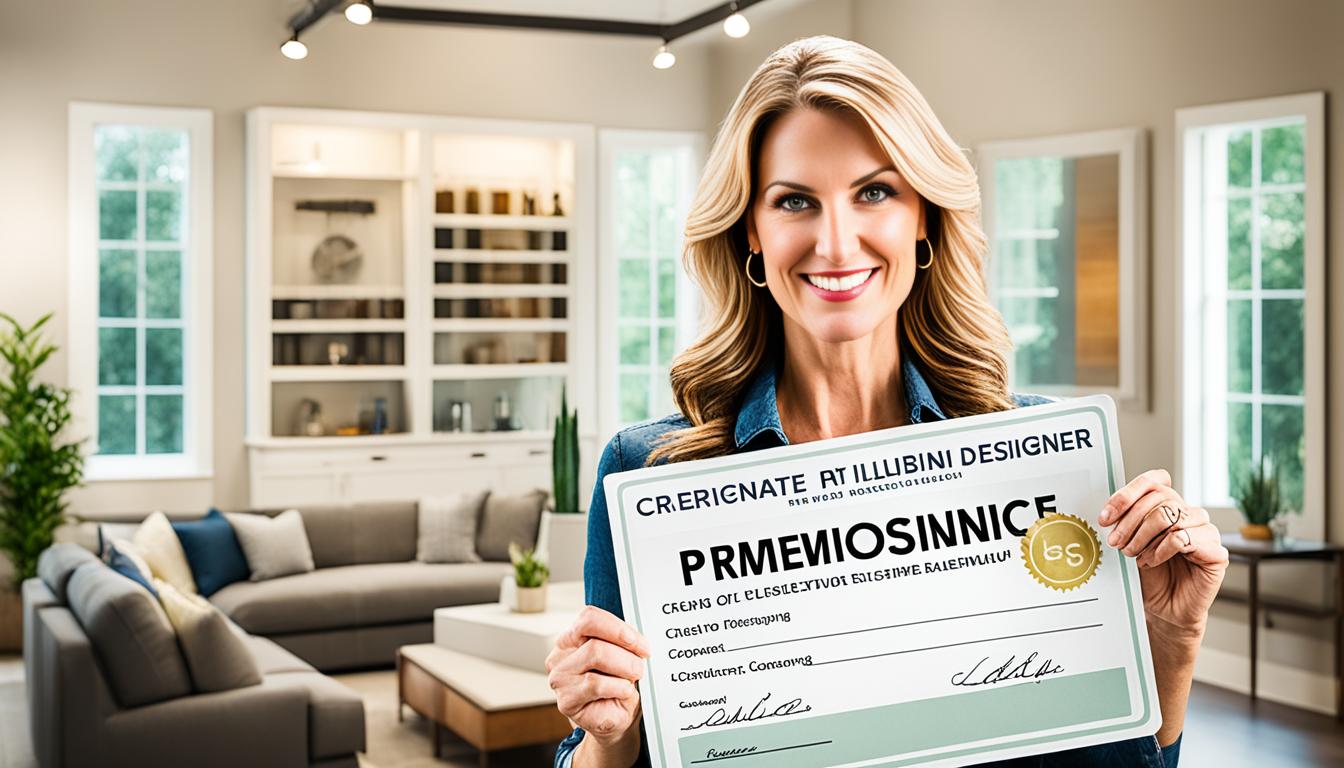Did you know that becoming a licensed interior designer opens up a world of opportunities and credibility in Canada? Whether you are just starting your career or looking to elevate your status as a professional, obtaining an interior design license is a crucial step towards success. In this guide, I will provide you with step-by-step instructions on how to get an interior design license and the certification requirements you need to meet.
Key Takeaways:
- Understanding the process and requirements for getting an interior design license in Canada
- Determining your ideal client and specializing your services to stand out in the industry
- Gaining practical experience through internships and mentorship programs
- Developing essential skills such as effective communication and technical knowledge
- Obtaining the necessary interior design certification, including the NCIDQ exam
Determine Your Ideal Client and Specialize Your Services
Before starting your interior design business, it’s crucial to define your ideal client and specialize in a specific niche. This strategic approach will set you apart in the industry, attracting clients who align with your expertise and style. To achieve success, take the time to research and understand the needs and preferences of your target audience.
By identifying your ideal client, you can tailor your services to meet their specific requirements, ultimately delivering exceptional results. Consider factors such as demographics, lifestyle, and design preferences when defining your target market. This insight will enable you to create personalized and impactful designs that resonate with your clients.
Specializing in a specific interior design niche adds a unique selling proposition to your business. By positioning yourself as an expert in a particular area, you’ll differentiate yourself from competitors and become the go-to designer in your chosen field.
Research the different interior design niches and evaluate which aligns best with your skills, interests, and market demand. Whether it’s residential, commercial, hospitality, or sustainable design, focus on honing your expertise in that particular area.
By determining your ideal client and specializing your services in a specific niche, you position yourself for success in the competitive world of interior design.
Gain Practical Experience Through Internships and Mentorship Programs
As an aspiring interior designer, gaining practical experience is essential to enhance your skills and knowledge in the field. One way to do this is by participating in interior design internships and mentorship programs. These opportunities provide you with valuable insights into the industry and allow you to learn from experienced professionals.
Interior design internships offer you the chance to apply your classroom knowledge in real-world settings. By working in a design studio or with a professional interior designer, you can gain hands-on experience in various aspects of the design process. This includes selecting materials, creating design concepts, and collaborating with clients.
Mentorship programs, on the other hand, provide you with guidance and support from established designers. Through mentorship, you can learn about the inner workings of the industry, gain valuable advice, and develop your professional network. Mentors can offer insights into their success stories, share industry trends, and help you navigate challenges along your career path.
When considering interior design internships and mentorship programs, it’s important to research and choose reputable opportunities. Look for programs that align with your specific interests and goals. Consider reaching out to design firms, studios, or professional organizations to inquire about available internships or mentorship programs.
Remember that internships and mentorship programs are not only about gaining practical experience, but also about building relationships and connections within the industry. Take advantage of these opportunities to network, ask questions, and learn from professionals who have already established themselves in the field.
Develop Essential Interior Design Skills
As an interior designer, developing a range of essential skills is crucial for success in the industry. In addition to your innate creativity and a keen eye for design, there are other key skills that will enhance your capabilities and set you apart from the competition.
Effective communication is one of the most essential interior design skills. Being able to clearly articulate your ideas and concepts to clients, contractors, and other stakeholders is vital for a successful project. Strong communication skills will not only help you understand and meet your clients’ expectations but also allow you to collaborate effectively with other professionals involved in the design process.
Organizational abilities are another important skill for interior designers. From managing project timelines and budgets to coordinating with suppliers and contractors, being organized is crucial for keeping projects on track and ensuring smooth operations. With excellent organizational skills, you can handle multiple projects simultaneously and deliver high-quality results within deadlines.
Time management is closely related to organizational abilities and is equally important for interior designers. Good time management practices will help you prioritize tasks, allocate resources efficiently, and meet project milestones. By effectively managing your time, you can provide exceptional service to your clients while maintaining a healthy work-life balance.
Technical knowledge is also vital for interior designers, particularly proficiency in computer-aided design (CAD) software. CAD tools enable you to create detailed design plans and realistic 3D visualizations, allowing clients to visualize the end result. Having technical expertise will also help you collaborate effectively with architects, engineers, and other professionals involved in the design and construction process.

Summary of Essential Interior Design Skills:
| Skills | Description |
|---|---|
| Effective Communication | The ability to convey design ideas and concepts clearly to clients and other stakeholders. |
| Organizational Abilities | The capacity to manage project timelines, budgets, and coordination with suppliers and contractors. |
| Time Management | The skill of efficiently allocating time, prioritizing tasks, and meeting project milestones. |
| Technical Knowledge | Proficiency in CAD software and other technical tools used in the interior design industry. |
By developing these essential interior design skills, you will not only enhance your professional capabilities but also build a strong foundation for a successful career in the industry.
Obtain the Necessary Interior Design Certification
To become a licensed interior designer in Canada, it is important to meet specific requirements and successfully pass the NCIDQ (National Council for Interior Design Qualification) exam. This rigorous exam evaluates your knowledge and skills in various areas including construction standards, design application, and project coordination.
Before you can be eligible to sit for the NCIDQ exam, there are certain prerequisites you need to fulfill. It is essential to earn a degree in interior design from an accredited institution. This can be an associate, bachelor’s, or master’s degree, depending on your career goals. Additionally, gaining practical work experience through internships or employment in the field is crucial to strengthen your knowledge and skills.
Once you have fulfilled the educational and experience requirements, you can proceed to register for the NCIDQ exam. This exam consists of three sections: the Interior Design Fundamentals Exam (IDFX), the Interior Design Professional Exam (IDPX), and the Practicum Exam.
The IDFX assesses your knowledge of the fundamental principles and practices of interior design. The IDPX tests your ability to apply design concepts and technical skills in real-world scenarios. The Practicum Exam evaluates your problem-solving and practical design abilities through a hands-on project.
Passing the NCIDQ exam demonstrates your competency as an interior designer and showcases your ability to meet industry standards. It is a crucial step towards obtaining your interior design license.

The NCIDQ Exam Structure:
| Exam Section | Content |
|---|---|
| Interior Design Fundamentals Exam (IDFX) | Knowledge of foundational design principles, human behavior, and building systems |
| Interior Design Professional Exam (IDPX) | Application of design concepts, knowledge of codes and regulations, and project coordination |
| Practicum Exam | Problem-solving and design skills demonstrated through a hands-on project |
Protect Your Interior Design Work Through Copyright
Copyright protection is crucial for interior designers to safeguard their original work from unauthorized copying. It applies to various elements of interior design, including illustrations, photographs, architectural plans, and design sketches.
Understanding copyright law and taking precautions, such as including copyright ownership terms in contracts and registering your work with the US Copyright Office, can help protect your designs.
By copyrighting your interior design work, you establish legal rights that prevent others from using, reproducing, or distributing your designs without your permission.
Registering your work with the US Copyright Office provides additional protection, as it creates a public record of ownership and allows you to take legal action against copyright infringement. This process helps prove your ownership in case of disputes and serves as a deterrent to potential infringers.
When drafting contracts with clients, it is essential to include copyright ownership terms. Clearly define the scope of the rights granted to the client and specify that you retain the copyright to your work. This ensures that you maintain control over your designs and prevents clients from using them without permission.
In cases of copyright infringement, you have legal recourse to defend your rights. It is important to document evidence of infringement, including copies of the original designs and any instances of unauthorized use. Consult with a legal professional specializing in intellectual property law to determine the best course of action.
Branding Yourself as an Interior Designer
Creating a strong personal brand is vital for interior designers to set themselves apart in the competitive market. Your brand should showcase your unique style and approach to design and resonate with your target audience. To establish a successful personal brand, pay attention to key branding elements such as graphic design, color palette, and language used in your marketing materials.
A well-crafted brand can attract clients and build credibility for your interior design business. By consistently delivering exceptional designs aligned with your brand values, you can create a lasting impression that sets you apart from competitors.
One effective way to enhance your personal brand is through showcasing your portfolio. Your portfolio will allow potential clients to see your past work and understand your design aesthetic. This can be done through an online portfolio website or a carefully curated physical portfolio.
Furthermore, engaging with your target audience through various marketing channels like social media platforms can help you build a strong online presence. By sharing your design inspirations, projects, and industry insights, you can establish yourself as an authority in the field of interior design.
Remember, personal branding is an ongoing process, so regularly assess and refine your brand to reflect your growth as an interior designer. With a unique and compelling personal brand, you can attract your ideal clients and stand out in the interior design industry.
Monitor and Protect Your Online Presence
As an interior designer, it is crucial to stay vigilant and monitor your work online to prevent unauthorized copying. By regularly checking various platforms and websites, you can identify instances of copyright infringement and take appropriate action.
To protect your designs, consider using copyright notices and watermarks on your digital assets. These visible indicators can serve as a deterrent to those who may attempt to copy your work without permission. Additionally, utilizing digital rights management tools can help safeguard your online content and ensure that it is used in accordance with your terms.
If you come across cases of copyright infringement, it is important to take action. Reach out to the responsible parties and inform them about the unauthorized use of your work. In some cases, platforms may have mechanisms in place for reporting copyright violations. By reporting these instances, you can protect your rights and maintain the integrity of your interior design creations.
